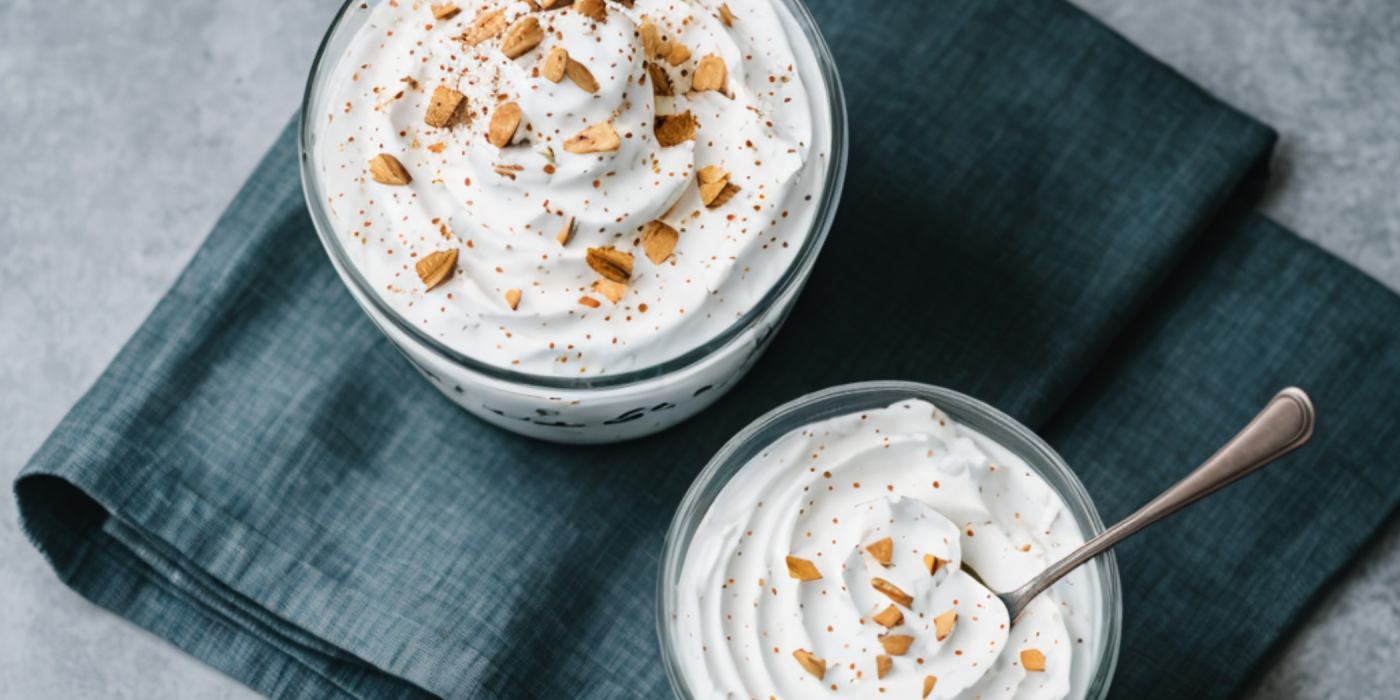The Wholesome Wonder of Yoghurt: Nutrition, Health Benefits, and Homemade Recipe

Yoghurt, a staple in many diets worldwide, has a rich and storied past that dates back thousands of years. Known for its creamy texture and tangy taste, it's not just a delightful treat but also a powerhouse of nutrients that contribute to our overall health and wellbeing. But what is yoghurt, exactly, and what makes it such a versatile and beneficial addition to our diet?
The Origins and Definition of Yoghurt
The story of yoghurt begins in ancient times, believed to be discovered accidentally as a result of milk being stored in warm conditions. The beneficial bacteria in the milk, when exposed to these warm conditions, fermented the milk into a thick, creamy, and tangy substance – what we now know as yoghurt. This method of preservation not only extended the shelf life of the milk but also introduced numerous health benefits which we continue to value today.
Yoghurt is a dairy product made by fermenting milk with a yoghurt culture, usually comprising strains of 'good' bacteria such as Lactobacillus bulgaricus and Streptococcus thermophilus. This fermentation process breaks down the lactose in the milk into lactic acid, which coagulates the milk proteins and gives yoghurt its distinct tart flavour and creamy texture.
Overview of the Article
In the following sections, we'll delve into the nutritional profile of yoghurt, looking at its rich array of vitamins, minerals, and other nutrients. We'll also discuss the numerous health benefits of consuming yoghurt and how it contributes to a balanced and healthy diet. Additionally, we'll guide you through making your own yoghurt at home, delve into the recommended daily amount, and answer some common questions about yoghurt. So, whether you're already a yoghurt lover or just curious about this nutritious food, read on to discover more.
As we delve into the nutritional profile of yoghurt, it's clear to see why it's often praised as a healthy choice.
Nutritional Breakdown
In terms of macronutrients, yoghurt is an excellent source of protein, with an average serving (around 200 grams) offering up approximately 10 grams. This contributes to the maintenance and growth of muscle mass, as well as supporting a multitude of bodily functions. Yoghurt also contains a moderate amount of carbohydrates, around 12 grams per serving, primarily in the form of natural sugars from milk known as lactose.
The fat content can vary considerably depending on whether you opt for whole milk or low-fat yoghurt. Whole milk yoghurt contains about 8 grams of fat per serving, whereas low-fat or fat-free versions contain significantly less. Importantly, a good portion of the fat in yoghurt is saturated fat, so it's worth bearing this in mind when considering your overall dietary intake.
Vitamins and Minerals
In addition to these macronutrients, yoghurt boasts a variety of essential vitamins and minerals. It's particularly rich in calcium, crucial for the health of our bones and teeth. You'll also find a good amount of vitamin B2 (riboflavin) and vitamin B12, both important for energy production and the functioning of the nervous system. Other notable minerals in yoghurt include phosphorus, key for bone health, and zinc, known for its role in immune function.
The nutritional composition of yoghurt makes it a versatile and valuable addition to our diets. In the following sections, we'll delve deeper into how these nutrients translate into health benefits.
The Health Benefits of Yoghurt
Digestive Health
A mainstay of many diets around the world, yoghurt plays a significant role in supporting digestive health. It's rich in probiotics, which are beneficial bacteria that can improve gut health. These friendly microorganisms aid in breaking down food, thus enhancing nutrient absorption. Furthermore, yoghurt's probiotics can be especially beneficial for those with digestive conditions such as irritable bowel syndrome, providing relief from symptoms.
Immune Function
The role of yoghurt in bolstering our body's defences is also noteworthy. The probiotics in yoghurt have been found to stimulate white blood cells, which are crucial for warding off infections. By improving gut health, they also aid in maintaining an overall robust immune system. Moreover, yoghurt is a good source of vital nutrients like zinc and vitamin D that further assist in enhancing immunity.
Bone Health
Finally, let's consider yoghurt's role in promoting bone health. This creamy dairy product is an excellent source of calcium, a mineral essential for the development and maintenance of healthy bones and teeth. Besides calcium, yoghurt also provides phosphorus and vitamin D, both necessary for optimal bone health. Regular intake of yoghurt could help prevent osteoporosis, a condition characterised by weak and brittle bones.
In sum, incorporating yoghurt into your diet can provide a raft of health benefits, contributing to a well-functioning digestive system, a robust immune response, and strong, healthy bones.
While yoghurt is easily available at any local supermarket, there's a unique satisfaction in making your own at home. Not only does homemade yoghurt allow for ingredient control, but it's also an economical and eco-friendly option. So, without further ado, let's explore how you can make your own yoghurt at home.
Step-by-Step Guide to Making Yoghurt
Ingredients
- 1 litre of full-fat milk
- 2 tablespoons of live yoghurt (this acts as your 'starter')
Method
- Start by heating the milk in a saucepan over medium heat until it begins to steam and form small bubbles around the edges (around 85°C if you have a cooking thermometer).
- Allow the milk to cool down to lukewarm (around 43°C). You can speed this up by placing the saucepan in a sink full of cold water. It's crucial not to rush this step, as too-hot milk can kill the yoghurt cultures.
- Once the milk is sufficiently cooled, whisk in the live yoghurt. Make sure it's thoroughly mixed in.
- Pour the mixture into a sterilised jar, close the lid, and wrap it in a towel to help maintain a consistent temperature.
- Leave the jar in a warm place for at least 8 hours or overnight. The oven with the light on (but not heated) works well. The longer it sits, the tangier the yoghurt will be.
- After the fermentation process, place the jar of yoghurt in the fridge for a few hours to thicken before consuming.
Tips for Achieving the Best Results
- Always start with high-quality ingredients. Opt for the best milk and live yoghurt starter you can find.
- The 'starter' yoghurt should contain live active cultures, often listed on the label.
- Each time you make yoghurt, save a bit of your homemade batch to use as the starter for the next one.
- Be patient. Good yoghurt takes time and rushing the process can affect the end result.
- Experiment with the process. The fermenting time, temperature, and type of milk used can all be adjusted to achieve your preferred taste and consistency.
With practice, you'll soon find the method and recipe that works best for you, providing you with delicious homemade yoghurt to enjoy on its own or incorporated into various dishes.
Recommended Daily Amount of Yoghurt
Yoghurt is a versatile food that can be incorporated into various meals throughout the day, but how much should we really be consuming? The recommended daily intake can vary based on individual nutritional needs and dietary restrictions. However, a common suggestion for adults is to aim for around 200g to 250g of yoghurt per day.
Balancing Your Diet with Yoghurt
Including yoghurt in your daily diet not only contributes to the intake of essential nutrients but also offers a source of probiotics known for promoting gut health. Its creamy texture and mild flavour make it a fitting companion to a range of foods, from fruits and granola at breakfast to sauces and marinades for dinner.
Having a serving of yoghurt in the morning can be a nutritious way to start the day, providing a source of high-quality protein, calcium, and vitamin D. It can also be enjoyed as a midday snack, providing a satiating combination of protein and carbohydrates to keep you fuelled until your next meal.
While yoghurt can be a valuable part of a balanced diet, remember that not all yoghurts are created equal. Those with added sugars or flavours may not offer the same health benefits as natural or Greek yoghurt. Always check the nutritional information on the packaging, and aim to choose varieties with no added sugar where possible.
Overall, the recommended daily amount of yoghurt can contribute significantly to meeting your daily nutritional requirements when consumed as part of a varied, balanced diet. As with any food, moderation and variety are key to enjoying the many benefits yoghurt has to offer.
Incorporating Yoghurt into Your Diet
If you're new to enjoying yoghurt or simply want to expand your horizons, there are a wealth of ways to integrate this nutritious and delicious food into your daily meals and snacks.
In the Morning
Start your day on a healthy note by including yoghurt in your breakfast. Yoghurt can be enjoyed as is, mixed with your favourite fruits, nuts, or seeds. Alternatively, use yoghurt as a base for smoothies or as a healthier replacement for milk in cereals.
Lunch and Dinner
Yoghurt can be a refreshing addition to your midday and evening meals as well. Use it as a base for dressings and sauces in salads and main dishes. In dishes that require cream or mayonnaise, substitute with yoghurt for a lighter, healthier alternative. It can also be served alongside spicy meals to balance the heat.
Snacks
For a quick and nutritious snack, dip your favourite fruits, veggies, or even whole grain crackers into yoghurt. You can also mix yoghurt with honey or pure maple syrup for a sweet treat.
Recipes
To get you started, here's a simple recipe for a Greek Yoghurt Dressing:
- In a bowl, mix 1 cup of Greek yoghurt, 2 tablespoons of olive oil, 1 tablespoon of lemon juice, and salt and pepper to taste.
- Stir in a handful of finely chopped fresh herbs such as dill, parsley, or chives.
- Adjust the seasoning if needed, and you've got a versatile dressing ready to be used in salads or as a dip.
Remember, when incorporating yoghurt into your diet, opt for the unflavoured, low-fat varieties when possible to avoid added sugars. Enjoy!
Yoghurt Varieties and How to Choose
Overview of Different Types of Yoghurt
Yoghurt comes in various forms, each with its unique characteristics and flavours. Some popular varieties include:
1. Greek Yoghurt
Greek yoghurt is known for its thick and creamy texture, achieved by straining the whey. It's rich in protein and has a tangy taste, making it a versatile option for both sweet and savoury dishes.
2. Natural Yoghurt
Natural yoghurt is the simplest form, made from milk and live cultures. It has a more subtle taste and is lower in fat compared to other varieties, making it a great choice for those watching their calorie intake.
3. Flavoured Yoghurt
Flavoured yoghurt is infused with various fruits, sweeteners, and flavourings. While they can be a tasty treat, be cautious of added sugars in some commercial brands. Opt for options with natural fruit and lower sugar content.
Tips on How to Choose a Healthy Yoghurt
When selecting yoghurt, keep these tips in mind to make a nutritious choice:
1. Check the Ingredients
Read the label and avoid yoghurts with excessive added sugars, artificial sweeteners, or unnecessary additives. Choose yoghurts with minimal ingredients, focusing on milk and live cultures.
2. Mind the Fat Content
Consider your dietary preferences and choose between full-fat, low-fat, or fat-free yoghurt. Full-fat yoghurt provides more satiety and can be a part of a balanced diet, while low-fat or fat-free options are lower in calories.
3. Look for Live Cultures
Ensure the yoghurt contains active live cultures, like Lactobacillus acidophilus and Bifidobacterium, to reap the probiotic benefits.
4. Opt for Unsweetened
If possible, select unsweetened yoghurt and add natural sweetness from fresh fruit or a drizzle of honey.
5. Choose Organic or Grass-Fed Varieties
Organic or grass-fed yoghurts may have higher nutrient levels and fewer chemicals from pesticides or hormones.
By being mindful of these factors, you can make informed choices and enjoy the goodness of yoghurt as a delicious and nutritious addition to your diet.
Frequently Asked Questions
Let's address some common queries about yoghurt to shed light on its suitability for different dietary needs and how to handle homemade yoghurt.
Can you consume yoghurt if you're lactose intolerant?
For individuals with lactose intolerance, yoghurt can often be better tolerated than other dairy products. During the fermentation process, yoghurt's active cultures partially break down lactose, making it easier to digest. Opting for yoghurt with live probiotics may further aid digestion. However, individual tolerance levels vary, so it's advisable to start with small amounts and monitor your body's response.
Is yoghurt suitable for people with a dairy allergy?
Unfortunately, yoghurt is not suitable for those with dairy allergies. While the fermentation process reduces lactose, it does not eliminate milk proteins, which are the culprits behind dairy allergies. For individuals with dairy allergies, there are plant-based yoghurt alternatives made from soy, almond, coconut, or other non-dairy sources.
How long does homemade yoghurt last?
When stored correctly in an airtight container in the refrigerator, homemade yoghurt can remain fresh for around 1 to 2 weeks. Its shelf life may vary based on factors like the storage temperature and the ingredients used. Trust your senses - if it develops an off smell, flavour, or texture, it's best not to consume it.
What's the difference between yoghurt and curd?
The terms "yoghurt" and "curd" are often used interchangeably in some regions. However, there are some differences between the two. Yoghurt is a fermented dairy product made by introducing specific bacterial cultures to milk. On the other hand, curd may refer to a similar product, but the fermentation process and bacterial cultures used can vary. In some places, curd can also refer to a milk product that has coagulated or thickened naturally without the addition of specific bacterial cultures. The terminology may differ depending on cultural and regional preferences.
Conclusion
In conclusion, yoghurt is a versatile and nutritious dairy product that offers numerous health benefits. With its rich nutritional profile containing essential proteins, carbohydrates, and fats, it provides a wholesome addition to your daily diet. The presence of vitamins and minerals, such as calcium and vitamin B12, further enhances its value in supporting bone health and contributing to overall well-being.
The health benefits of yoghurt go beyond its nutrient content. It promotes digestive health by providing probiotics, which aid in maintaining a healthy gut flora. Additionally, the immune-boosting properties of yoghurt help fortify your body's defense system.
Making yoghurt at home allows you to control the ingredients and the fermentation process, ensuring a fresh and delicious end product. By following our simple step-by-step guide, you can enjoy homemade yoghurt with ease.
Incorporating yoghurt into your diet can be as simple as enjoying it as a snack or using it as a creamy addition to your favourite dishes. The versatility of yoghurt opens the door to a myriad of possibilities in the kitchen, from smoothies and parfaits to savoury dips and dressings.
Whether you choose Greek yoghurt, natural yoghurt, or any other variety, be mindful of the added sugars in flavoured versions. Opting for plain yoghurt and sweetening it naturally with fruits or honey is a healthier choice.
So, why not embrace the goodness of yoghurt and make it a regular part of your daily routine? With its numerous health benefits and delicious taste, yoghurt is a delightful addition to any balanced diet. Your body and taste buds will surely thank you for it!
Related to this article are the following:
- Unlocking Sauerkraut: A Comprehensive Guide to Its Nutrition, Health Benefits, and DIY Recipe
- Miso Demystified: Nutritional Insights, Health Gains, and a Homemade Recipe
- The Ultimate Kefir Guide: Nutrients, Health Benefits, Recipe and More
- Unveiling Vitamin B12: Its Importance, Food Sources, Vegetarian Options, Deficiency Symptoms and Benefits of Adequate Intake
- Vitamin D Uncovered: Identifying the Foods Rich in the Sunshine Vitamin and Their Impact on Health
I do hope you have enjoyed this article and hope that you will subscribe to my newsletter so you can get the latest information about all things naturally relaxing.
Stay in touch, join the Naturally Relaxing Newsletter
Newsletter Signup
Post Your Comments
or post as a guest
Be the first to comment.
Latest articles in Food

Hot Cross Buns This Easter: A Timeless Tradition of Baking and Sharing

Chocolate Krispie Cakes for Easter: A Simple, Festive Treat for All

2023 Christmas Culinary Delights: Recipes for the Ultimate Festive Feast

Embrace Autumn with the Best Pumpkin Spice Recipes in the UK

Turning Pumpkin Carvings into Pumpkin Pie: A British Culinary Tradition






